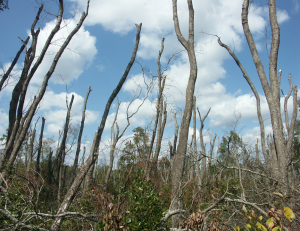
Redbay is one of the most vulnerable of United States tree species because of laurel wilt, a devastating disease spread by a nonnative insect.
Hemlock woolly adelgid, gypsy moth, emerald ash borer: ask any USDA Forest Service scientist which insects and diseases pose a threat to our forests, and they could probably name a baker’s dozen. A huge number of insects and diseases have the potential to negatively affect tree species in the United States.
However, the danger is not uniform; the susceptibility of a tree species to a certain risk is influenced by geography, forest health, pest and disease concentrations, and more.
A recent study by USDA Forest Service research cooperator Kevin Potter, North Carolina State University partners Maria E. Escanferla and Robert M. Jetton, and Forest Health Protection scientist Gary Man determined how at-risk U.S. tree species are from insects and diseases. Their results were published in Forests.
A lot of thought – and work – went into designing the framework. “We put together a list of 419 U.S. tree species,” says Potter, a research associate professor in the Department of Forestry and Environmental resources at NC State University. “For each species we compiled a list of up to five insect or disease threats. For each of those threats, we assigned a severity rating from one to ten. One was minor mortality, and ten meant almost complete annihilation of the species.” This resulted in 1,378 combinations between the tree species and 339 distinct insect and disease agents.
The scientists then combined this species-specific severity list with data from approximately 132,000 Forest Inventory and Analysis (FIA) plots from across the lower 48 states to assess potential ecological impacts of insect and disease infestations across the nation.
The study found that forests in the West have the potential to be greatly impacted by insects and diseases, since forests there tend to be dominated by fewer tree species. Lower forest diversity makes the area more susceptible, especially since insects and diseases can have a larger impact on individual forest stands, even though there are fewer pest species overall.
The impact of nonnative invasive agents was potentially greater in the East, where more of these species have been introduced by international trade and where there are more host species to allow them to gain a foothold. Their impact could be even more significant if these agents eventually reach the entirety of the ranges of their tree hosts.
Potter led a follow-up study with the same team, plus geneticist Barbara Crane. For this work, their goal was to categorize the 419 tree species examined in the first study into different groups based on their conservation, monitoring, and management needs. These findings were published in Global Ecology and Conservation.
The team assessed three vulnerability factors of each species: insect and disease threat severity, sensitivity to insect and disease infestation, and capacity to adapt to insect and disease infestation. They clustered species into 11 classes based on similarities in their vulnerability factors.
The three most vulnerable classes include 15 tree species that require the most urgent conservation attention, such as immediate seed collection. These include American chestnut, redbay, Carolina hemlock, eastern hemlock, butternut, and ash, among others.
Two other classes are composed of species facing less severe insect and disease threats. These could be good candidates for long-term management strategies like resistance breeding. Other groups with traits like lower sensitivity or higher capacity to adapt to infestation agents may be best suited for monitoring.
“The big picture is that we have limited resources to deal with threats that face our tree species, so we need tools like this to direct our attention to tree species that most need immediate attention,” emphasizes Potter. “We identified that certain species are in desperate need, but the framework also helps us figure out other groups of species that are not currently obvious as being vulnerable. Those are the species that we need to keep an eye on or do proactive management to make sure they’re healthy.”
For more information, see this blog posting from the U.S. Forest Service Southern Research Station.
September 3, 2019



